PPC advertising can feel like a scary world to venture into—after all, you’re spending precious dollars. But the fact of the matter is, you have to spend money to make money, and the good news is, digital platforms give us tons of data to work with so we can identify what’s worth our money, what’s not, and how to get more for each dollar we spend.
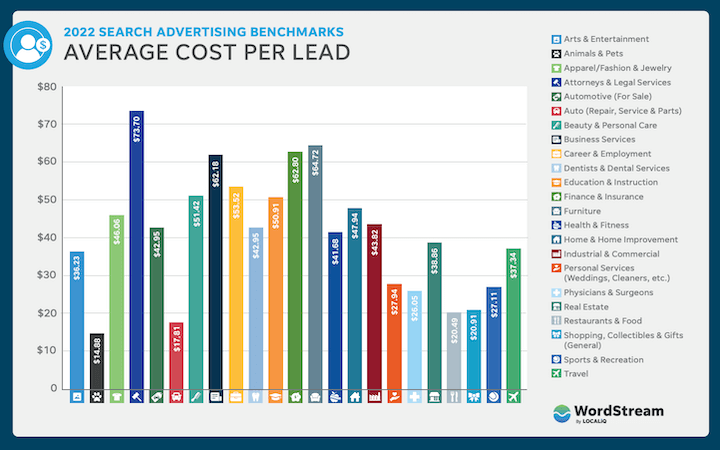
Not to mention advertising benchmarks that help us know what to strive for.
In the case of Google Ads, we have lots of metrics to help us out, and one of the most important ones when it comes to costs is your cost per lead. Read on to learn what it is and how you can lower your cost per lead so you can actually be sure that you’re making money with the money you spend.
Table of contents
What is cost per lead?
Cost per lead is a PPC metric that tells you how much it costs for you to generate a conversion from your ad(s). A conversion is whatever action you want users to take from your ad, whether that’s to book an appointment, download a guide, submit a contact form, make a purchase, or something else—so it makes sense that cost per lead is also known as cost per action or cost per conversion.
The cost per lead formula is cost / conversions. If you spend $500 on a campaign and get 50 conversions, your CPL is $10.
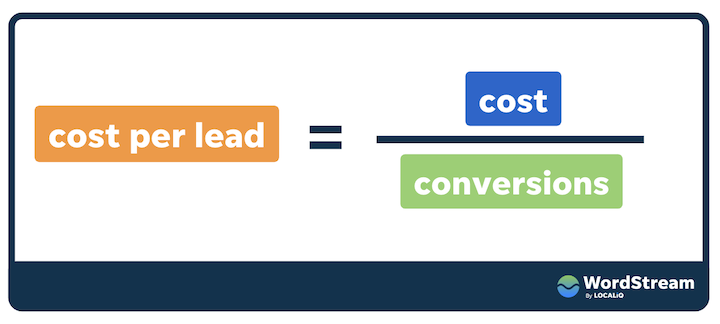
Given that formula, lowering your CPA means finding out where you can increase conversions and/or decrease costs. But it’s not exactly that black and white.
First of all, any given Google Ads account likely has multiple campaigns and multiple keywords—each one varying in how much value a conversion brings to your business. Then there are other factors like the maturity of your campaigns and conversion rate optimization efforts, your overall budget, and the resources you have.
As a result, lowering your CPL is most likely going to be a mix of actions taken on a mix of campaigns within your account. Let’s take a look.
What’s a good cost per lead?
What constitutes a “good” cost per lead varies widely depending on which industry you’re in. For example, the average CPL for the Furniture, Career/Employment, Legal, and Business Services industries is over $70, while for Automotive Repair/Service/Parts and Animals/Petes, it’s less than $20.
You can view all our online advertising benchmark data here.
Also, within your account, you may see different CPLs for different keywords and campaigns, since some offers are higher value than others.
How to lower cost per lead in Google Ads
As I just mentioned, there is no prescriptive formula for lowering your cost per lead that works for every account. Yes, it's a matter of increasing conversions and/or decreasing costs, but there are several ways to go about each of those. We're going to run through those now.
1. Check up on your “limited by budget” campaigns
One way you could lower your costs is by lowering your bids, and this comes down to your “limited by budget” campaigns. “Limited by budget” is a campaign status in Google Ads that means that your bids are high enough to make you eligible to enter a certain number of auctions, but that you don’t have the budget to appear in that many auctions.
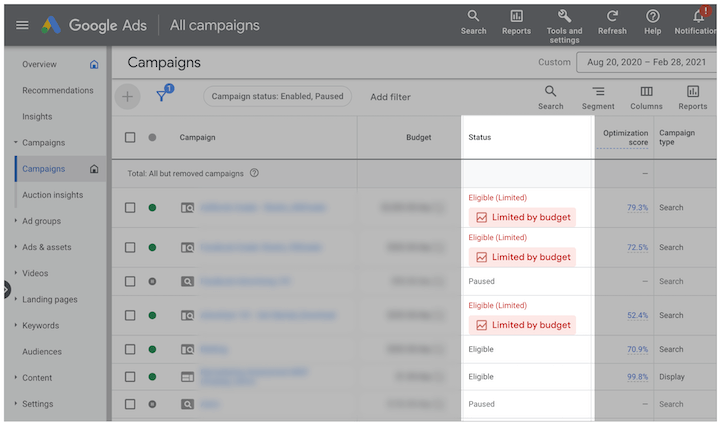
For campaigns with this status, you could:
- Increase budget. If this is a high-value campaign and you can afford it, you can increase your budget. This could lead to more conversions, but remember, if your spend increases more than your conversions increase, your CPL won’t change.
- Lower your bids. This will enter you into cheaper auctions, which will earn you cheaper clicks at lower ad positions. Just keep an eye on your conversion volume. If your lower bids reduce your CPA by 30% but also bringn down your average position and reduce your conversion volume by 50%, it’s not worth it.
- Use the “Search lost IS (budget)” column (aka impression share lost to budget) and “Estimated first page bid” column to see just how limited by budget a campaign is and how high you need to keep your bid.
If one of your higher CPL campaigns is not limited by budget but is a high-value campaign, you can look to lower bids/budgets in lower-value campaigns to bring down your overall CPL in your account.
2. Amp up your Quality Score
A lower bid can lower your cost per click, which in turn lowers your overall CPL. But how can you win the Google Ads auction with a lower bid? With a high Quality Score. The way the Google Ads auction works is, Google rewards quality ads with lower costs per click.
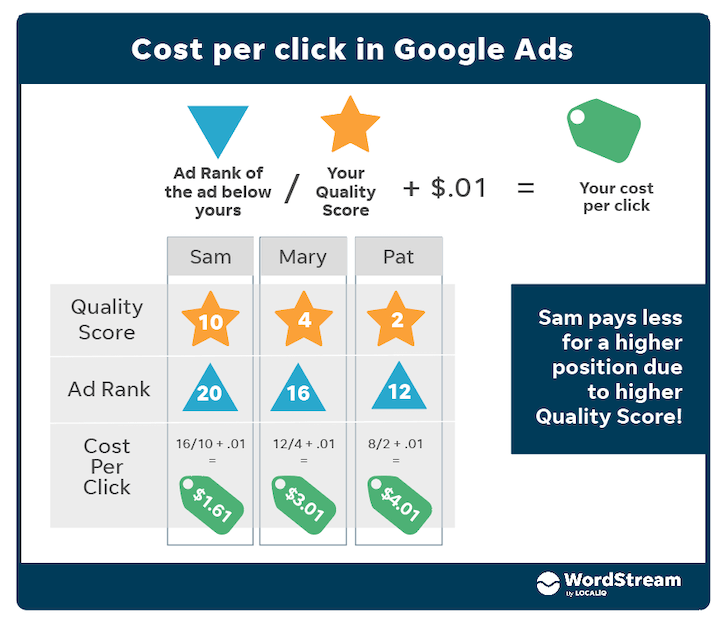
To improve your Quality Score, you need to understand its three components:
- Expected click-through rate: Use our tips to improve your CTR, such as using ad extensions, ad customizers and improving your ad copy, which will elevate your expected CTR.
- Landing page experience: We'll talk more about landing pages later on, but the main idea here is to make sure they're trustworthy and useful to the people who click on your ad. Follow our tips on how to lower your CPC with landing page optimization.
- Ad relevance: This means making sure there is tight alignment between your keywords and their associated ads and landing pages. More tips on that next.
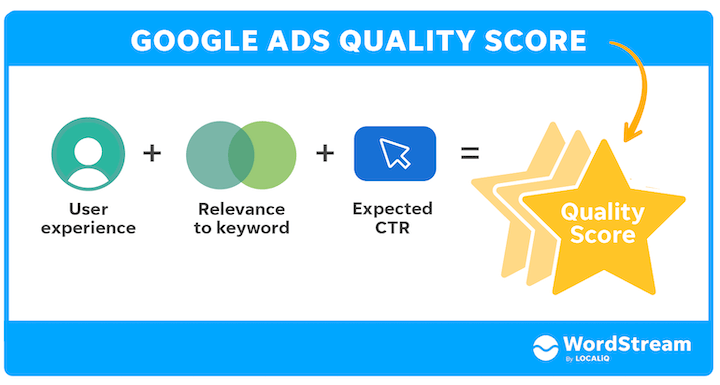
✴️ How does your Quality Score compare to others in your industry?
Use the Free Google Ads Grader to get insights on your Quality Score, impression share, wasted spend & more.
3. Tighten up your account structure
Your account structure refers to the way you organize your keywords and ads into ad groups and then those ad groups into campaigns. A proper account structure is important in reducing CPA in a few ways:
- Single-themed ad groups will ensure your keywords, ads, and landing pages are tightly aligned, improving relevancy and therefore also Quality Score.
- Automated bidding strategies are set at the campaign level, so with the right organization, you ensure that you’re giving Google both the adequate and consistent data it needs to optimize your bids and keep your costs in check.
- Since budgets are set at the campaign level, you can more easily distribute budgets when your campaigns are organized accordingly (such as by following tip #1).
- When your keywords are assembled into themed ad groups, you can more easily detect CPL patterns and distribute your budget according to how the keywords in those ad groups are performing (more on that later on).

4. Tune up your bids…
Take a look at your campaigns and make sure you’re not leaking any spend on campaign settings or targeting. If you're using Manual or Enhanced CPC bidding, you can make bid adjustments based on:
- Device: Desktop, mobile, tablet, etc.
- Demographic: Age, gender, location, etc.
- Audience: Detailed demographics, in-market, affinity, custom segments, etc.
- Networks: Search, Display, or Partner network.
- Time of day: Depending on your ad schedule.
If a particular time of day, network, location, or device is lagging in conversion rates, exclude those segments or adjust your bids accordingly.
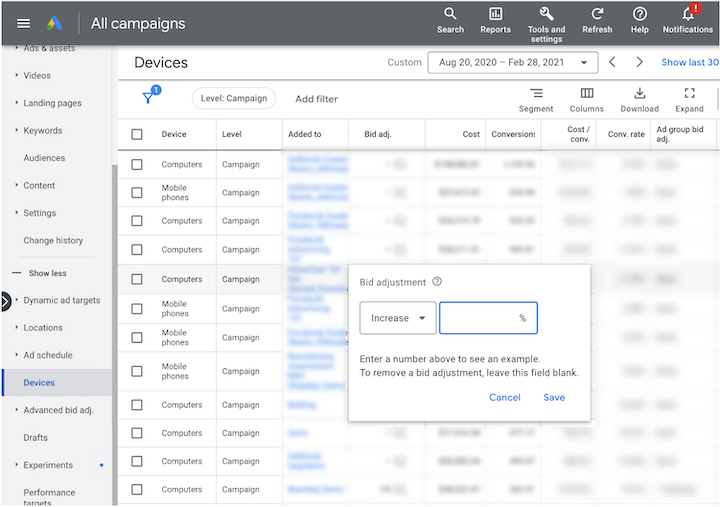
5. …or your targets
If you're using an automated bidding strategy, your ability to adjust bids is much more limited, but you can adjust your targets. For example, if you're using the Max Conversions bidding strategy, you can set a target CPA (tCPA).
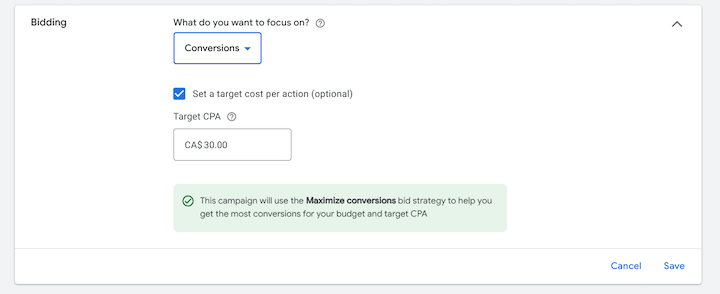
If you know what a conversion needs to cost in order to be profitable, setting a target CPA is a great way to control costs.
Just make sure you set a realistic target. If you set your goal too low, Google may have a hard time finding auctions that meet those conditions—this can result in fewer impressions, which can lead to fewer clicks and eventually fewer conversions, which will hike up your CPL.
6. Clean up your keywords
As mentioned in tip #3, having an optimal account structure allows you to more easily detect patterns in keyword performance. Here are some of the patterns to look out for and what action you can take for lowering your CPL.
- Nurture your high-performing keywords: Find keywords with low costs per click and high conversion rates and allocate more budget to those campaigns.
- Maintain a negative keyword list. Use the search terms report and look for keywords that have:
- Lots of clicks but low/no conversions.
- At least 3 conversions but a CPA way over your target (3-4x higher).
- Decent impression count but low click-through rate
- Pause keywords. You may also want to pause keywords that have CPAs 2x higher than your account average. You could remove them but you may as well pause them to preserve historical data.
- Make sure keyword volume is sufficient. Improving the Quality Score of your keywords is all well and good, but this will not make a dent on your CPL numbers if your high QS keywords have super-low volume.

7. Spruce up your landing pages
If you’re targeting the right audience with super-relevant ads and landing pages but not seeing conversions, you may need to do some landing page optimization. After all, you can have your landing page best practices in place that meet Quality Score requirements—relevant, useful, loads quickly—but also have room for improvement. There are a number of options can you test out and optimize, including:
- Forms: Number of form fields, placeholder text, form button CTA.
- Buttons: Colors, language, number of buttons.
- Copy: Emotional framing, size and colors of text, testimonials, dynamic content.
- Images: Faces with testimonials, platform screenshots, positive or negatively charged.
- Additional features: Dynamic content, live chat, video.
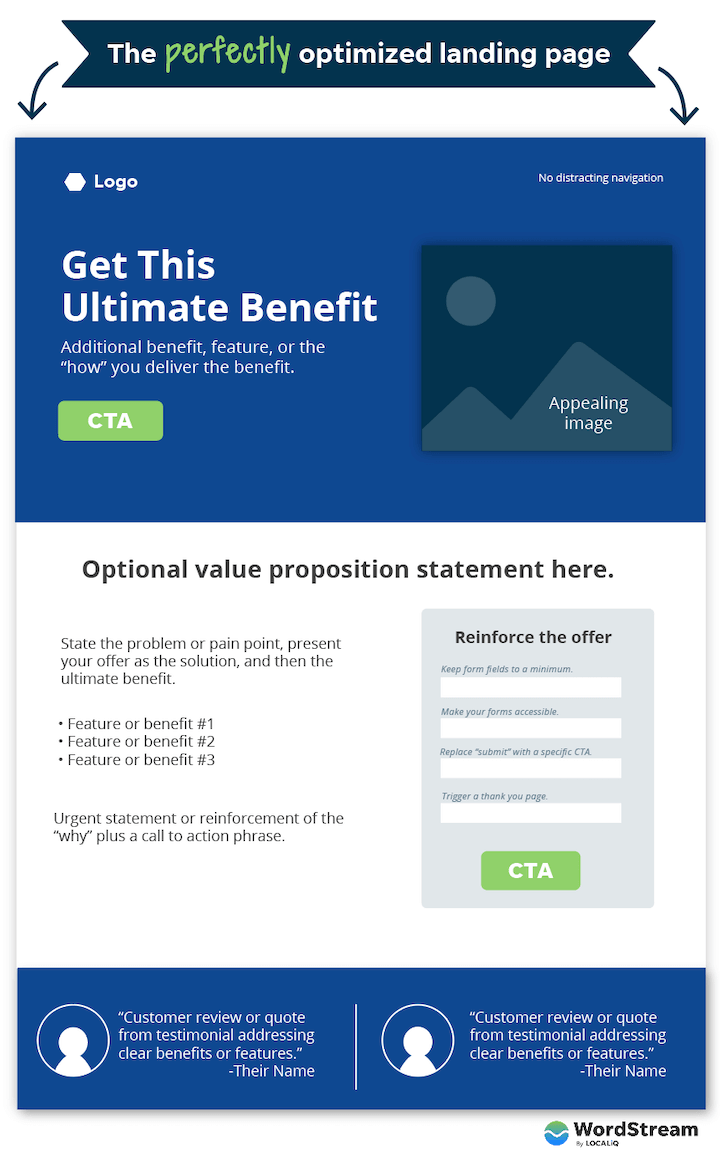
For help with your landing pages, you can refer to our complete landing page guide, follow our landing page tips and tricks, or take a look at these landing page examples for inspiration.
8. Tidy up your conversion tracking
The last strategy for decreasing your cost per lead in Google Ads is to make sure your conversion tracking is in good shape. That means:
- Set it up in the first place. Use our easy guide to conversion tracking to make sure you have all your ducks in a row.
- Take care of hangups. Maybe you have it set up but you're seeing gaps in data. See if you're stuck on any of these conversion tracking hangups.
- Set up offline conversion tracking. Syncing your CRM with Google Ads can help you gain a more comprehensive view of which keywords and targeting criteria drive the most cost-effective conversions. You can also segment and target even more granularly. Check out Google's help page on offline conversion tracking to see what your options are.
- Set conversion values regardless. Make sure you’re setting conversion values, regardless of whether you're using a value-based bidding strategy. This will allow Google to collect the data for if you do decide to go that route. Plus, you'll get a better view of your account performance overall. Here's how to set conversion values, even if you're not ecommerce.
You can also use our free Google Ads Grader to see if you're making any other costly mistakes with your account.
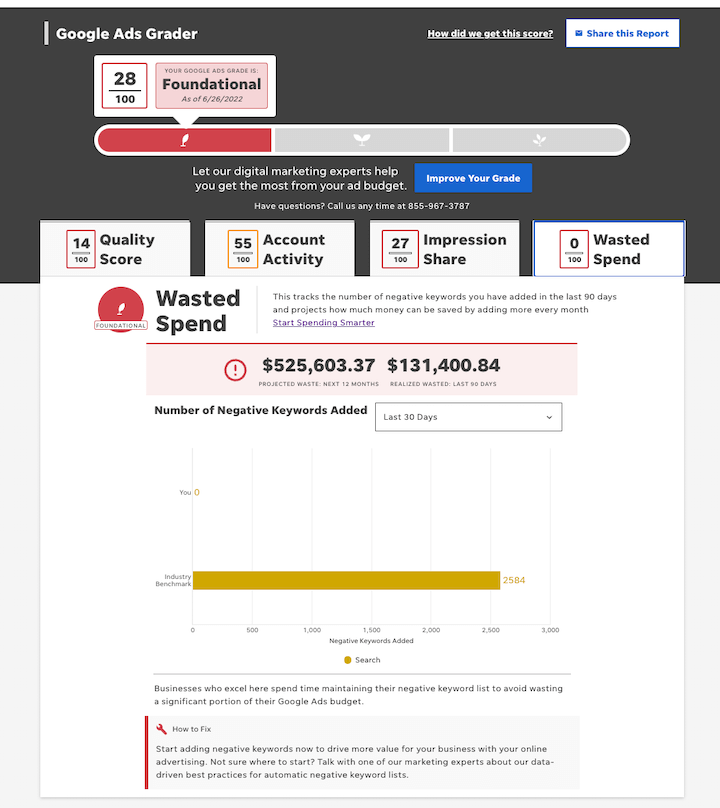
Use these tips to lower your cost per lead in Google Ads
As you can now see, lowering your cost per lead in Google Ads doesn't just come down to one particular action or campaign, but rather a mix of adjustments throughout your account depending on which campaigns have the most value, have room to grow, or room for improvement. Take a look at your campaigns and see which strategies make the most sense for your account.
To recap, here are the eight ways to lower your cost per lead (or cost per action) in Google Ads:
- Look at your “limited by budget” campaigns.
- Improve your Quality Score.
- Optimize your account structure.
- Adjust your bids for manual/enhanced CPC campaigns.
- Adjust your targets for automatic bidding campaigns.
- Nurture, pause, or negate keywords according to their performance.
- Optimize for conversion.
- Make sure your online and offline conversion tracking is in top shape.
The post How to Lower Your Cost Per Lead in Google Ads: 8 Tried & True Tips appeared first on WordStream.


Recent Comments